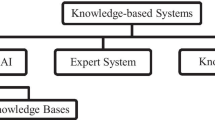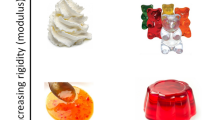Abstract
The correct assessment of meat quality (i.e., to fulfill the consumer’s needs) is crucial element within the meat industry. Although there are several factors that affect the perception of taste, tenderness is considered the most important characteristic. In this paper, a Feature Selection procedure, based on a Sensitivity Analysis, is combined with a Support Vector Machine, in order to predict lamb meat tenderness. This real-world problem is defined in terms of two difficult regression tasks, by modeling objective (e.g. Warner–Bratzler Shear force) and subjective (e.g. human taste panel) measurements. In both cases, the proposed solution is competitive when compared with other neural (e.g. Multilayer Perceptron) and Multiple Regression approaches.
Similar content being viewed by others
Abbreviations
- FS:
-
Feature Selection
- MR:
-
Multiple Regression
- NN:
-
Neural Network
- SVM:
-
Support Vector Machine
- STP:
-
Sensory Taste Panel
- WBS:
-
Warner–Bratzler Shear
References
Arvanitoyannis I., Houwelingen-Koukaliaroglou M. (2003), Implementation of chemometrics for quality control and authentication of meat and meat products. Critical Reviews in Food Science and Nutrition 43(2): 173–218
Bengio Y., Delalleau O., Le Roux N. (2005). The curse of dimensionality for local kernel machines. Technical Report 1258, Department IRO, Universitsité de Montréal, Canada
Bi J. and Bennett, K. Regression error characteristic curves. In: Proceedings of 20 th International Conference on Machine Learning (ICML), Washington DC, USA (2003).
Chang, C., Hsu, C. and Lin, C. A practical guide to support vector classification. http://www.csie.ntu.edu.tw/ cjlin/papers/guide/guide.pdf. Department of Computer Science and Information Engineering, National Taiwan University (2003).
Cherkassy V., Ma Y. (2004), Practical selection of SVM parameters and noise estimation for SVM regression. Neural Networks 17(1): 113–126
Diéz, J., Bayón, G., Quevedo, J., Coz, J., Luaces, O., Alonso, J. and Bahamonde, A. Discovering relevancies in very difficult regression problems: applications to sensory data analysis. In Proceedings of ECAI, 993–994, Valencia, Spain, IOS Press (2004).
Flexer, A. Statistical evaluation of neural networks experiments: Minimum requirements and current practice. In Proceedings of the 13th European Meeting on Cybernetics and Systems Research, vol 2, pp. 1005–1008, Austrian Society for Cybernetic Studies, Vienna (1996).
Hastie T., Tibshirani R., Friedman J. (2001). The Elements of Statistical Learning: Data Mining, Inference, and Prediction. Springer-Verlag, NY
Haykin S. (1999). Neural Networks – A Compreensive Foundation. 2nd edn, Prentice-Hall, NJ
Hill B., Jones S., Robertson W., Major I. (2000), Neural network modeling of carcass measurements to predict beef tenderness. Canadian Journal of Animal Science 80: 311–318
Huffman K., Miller M., Hoover L., Wu C., Brittin H., Ramsey C. (1997), Effect of beef tenderness on consumer satisfaction with steaks consumed in the home and restaurant. Journal of Animal Science 74(1): 91–97
Kewley R., Embrechts M., Breneman C. (2000), Data strip mining for the virtual design of pharmaceuticals with neural networks. IEEE Transactions on Neural Networks 11(3): 668–679
Kohavi, R. A study of cross-validation and bootstrap for accuracy estimation and model selection. In Proceedings of the International Joint Conference on Artificial Intelligence (IJCAI), Montreal, Canada (1995).
Lavrac N., Motoda H., Fawcett T., Langley P., Adriaans P. (2004), Introduction: lessons learned from data mining applications and collaborative problem solving. Machine Learning 57(1–2): 13–32
Li J., Tan J., Martz F., Heymann H. (1999), Image texture features as indicators of beef tendernes. Meat Science 53(1): 17–22
Mitra S., Pal S., Mitra P. (2002), Data mining in soft computing framework: a survey. IEEE Transactions on Neural Networks 13(1): 3–14
R Development Core Team. R: A Language and Environment for Statistical Computing. R Foundation for Statistical Computing, Vienna, Austria, http://www.R-project.org, ISBN 3-900051-07-0 (2005).
Smola A., Scholkopf B. (1998). A tutorial on support vector regression. Technical Report NC2-TR-1998-030, University of London, UK
Turban E., Aronson J., Liang T. (2004). Decision Support Systems and Intelligent Systems. Prentice-Hall, NJ
Vapnik V. (1999). The Nature of Satistical Learning Theory, 2nd edn. Springer, Berlin
Author information
Authors and Affiliations
Corresponding author
Rights and permissions
About this article
Cite this article
Cortez, P., Portelinha, M., Rodrigues, S. et al. Lamb Meat Quality Assessment by Support Vector Machines. Neural Process Lett 24, 41–51 (2006). https://doi.org/10.1007/s11063-006-9009-6
Published:
Issue Date:
DOI: https://doi.org/10.1007/s11063-006-9009-6




